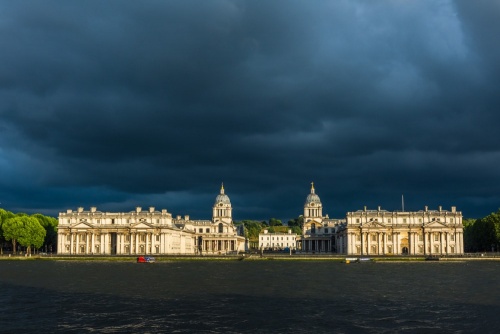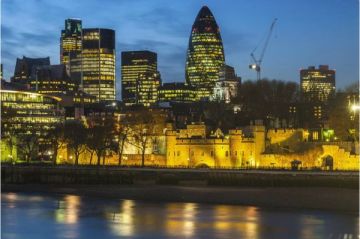
History
There was a Tudor royal palace at Greenwich, built by Henry VII and later rebuilt by Henry VIII to create an opulent residence on the south bank of the Thames. Among the delights built by Henry VIII were a tiltyard, stables, kennels, a cockpit and tennis courts, for Henry was fond of the game.
Both Mary I and Elizabeth I were born at Greenwich Palace, and it was one of Elizabeth's favourite retreats when she took the throne. Later Stuart monarchs did not favour Greenwich so much, and by the middle of the 17th century the palace was crumbling into ruin.

from Island Gardens ...
In 1664 Charles II called in architect John Webb to rebuild the palace. As it happened, only one wing of the king's new palace was built. This is the King Charles Block, and it is one of the few surviving examples of Webb's work.
When William and Mary took the throne, they decided to move to Hampton Court, and the palatial Greenwich scheme was abandoned.
Instead, Sir Christopher Wren was called in to design a naval hospital, a place for injured and retired seamen, to rival the Royal Chelsea Hospital for soldiers that had been established just a few years before. The new Greenwich Naval Hospital was to be even more imposing than Chelsea.
Wren decided to create a pair of imposing blocks with domed towers - the King William Block and the Queen Mary Block - set back from the riverside, and linked by colonnades, with a second set of blocks closer to the river.

The domes are similar to the striking dome of St Paul's Cathedral, though quite a bit smaller. Each tower has a clock face, but it is fascinating to note that one of the clock faces does not mark the hours, but rather the points of the compass, with a marker linked to a weather vane on the roof. That way, ships on the Thames could see at a glance which direction the wind was blowing.
Half-hidden behind the King William Block is the King William Court, which rather obviously clashes with the rest of the design. This is usually attributed to Nicholas Hawksmoor, Wren's longtime assistant. In 1718 Wren was deposed as Surveyor-General, and Thomas Ripley finished the complex in an unremarkable Palladian style.
The Hospital closed in 1869. Part of the complex was used as a naval training college, and part is now used by the University of Greenwich. The Painted Hall and Chapel are open to visitors, however.
Painted Hall
The undoubted highlight of the Old Royal Naval College is the astonishing Painted Hall, occupying King William's Block. There are two main halls, the main lower hall linked by a short flight of steps to an upper hall.
Every surface is covered in an astonishingly lush painting, designed by James Thornhill, full of classical allegory. It took Thornhill fully 19 years to complete the painting, from 1708-12 and 1718-28.
The centrepiece of the main ceiling depicts William and Mary surrounded by a plethora of gods and goddesses, cherubs and classical motifs. William is shown with his foot crushing Louis XIV of France; this political statement is very much the purpose of the Painted Hall; everywhere you look there are allusions to the glory of Britain and the splendour of the monarchy.
The main hall is lined with trompe l'oiel classical columns, and in the floor of the upper hall is a memorial to Admiral Nelson, the hero of Trafalgar. It was here that Nelson's body was brought to lie in state before his burial at St Paul's Cathedral. It is said that the queue of mourners waiting to enter the Hall stretched for miles.
When we visited, the paintings were being cleaned, and visitors were invited to contribute £1 to 'adopt' a face. We complied, so if you look in the upper hall, the painting of Providence is ours!



The Chapel
Occupying Queen Mary's Block, opposite from the King William Block, is the chapel. Though it is on a much less grandiose scale than the Painted Hall, it is an amazing space, decorated throughout with symbols of naval life.
The interior was designed by James Stuart in 1789, in neo-Grecian style, with gilded Corinthian columns and rich decoration throughout. Of special note is the chapel ceiling, designed by a master plasterer named John Papworth. The design is exquisite, with carved central bosses, plastered in cream and light blue, looking very much like a piece of Wedgwood china.
In the vestibule just outside the chapel is a memorial to Sir John Franklin, the Arctic explorer, who perished in his attempt to find the Northwest Passage in 1845. The monument gains a poignant significance when you realise that there is a second monument, on the river bank, to a French captain named Bellot, who tried to find Franklin and also perished.



Visiting
Wow! I was blown away by the Painted Hall. The painting is simply stunning, but that's only part of the story. The architecture of the entire complex is astounding. The long colonnades linking the tower blocks create such a wonderful vista of light and dark. This is a place to linger, and simply enjoy the pleasure of the magnificent surroundings.
The best views of the Naval College are actually from across the River Thames at Island Gardens. Just take the pedestrian tunnel under the river (entrance by the Cutty Sark). It takes roughly 8-10 minutes to walk under the Thames (though I once made it in 6 minutes because I was desperate to photograph the Old Royal Naval College before the late evening sunlight faded). In the late afternoon and evening on a sunny day, you can see the river facade lit by the glow of the sun and the effect is truly stunning.



About Old Royal Naval College Greenwich
Address: King William Walk,
London,
Greater London,
England, SE10 9NN
Attraction Type: Historic Building
Location: Immediately beside the Cutty Sark and Discover Greenwich. Free entry. The nearest station is Cutty Sark, on the DLR.
Website: Old Royal Naval College Greenwich
Email: info@ornc.org
Location
map
OS: TQ383778
Photo Credit: David Ross and Britain Express
Nearest station: ![]() Cutty Sark - 0 miles (straight line) - Zone: 2.5
Cutty Sark - 0 miles (straight line) - Zone: 2.5
NEARBY HISTORIC ATTRACTIONS
Heritage Rated from 1- 5 (low to exceptional) on historic interest
Cutty Sark - 0.1 miles (Museum) ![]()
St Alfege's Church, Greenwich - 0.2 miles (Historic Church) ![]()
Queens House - 0.2 miles (Historic Building) ![]()
National Maritime Museum - 0.2 miles (Museum) ![]()
Greenwich Park - 0.5 miles (Countryside) ![]()
Royal Observatory, Greenwich - 0.5 miles (Museum) ![]()
Queen Elizabeth's Oak - 0.6 miles (Countryside) ![]()
Ranger's House - 0.7 miles (Historic Building) ![]()
Nearest Holiday Cottages to Old Royal Naval College Greenwich:
Leaves Green, Greater London
Sleeps: 6
Stay from: £847.00 - 3941.00
Waltham Abbey, Essex
Sleeps: 6
Stay from: £946.00 - 4358.00
Loughton, Essex
Sleeps: 5
Stay from: £800.00 - 3670.00
More self catering near Old Royal Naval College Greenwich













